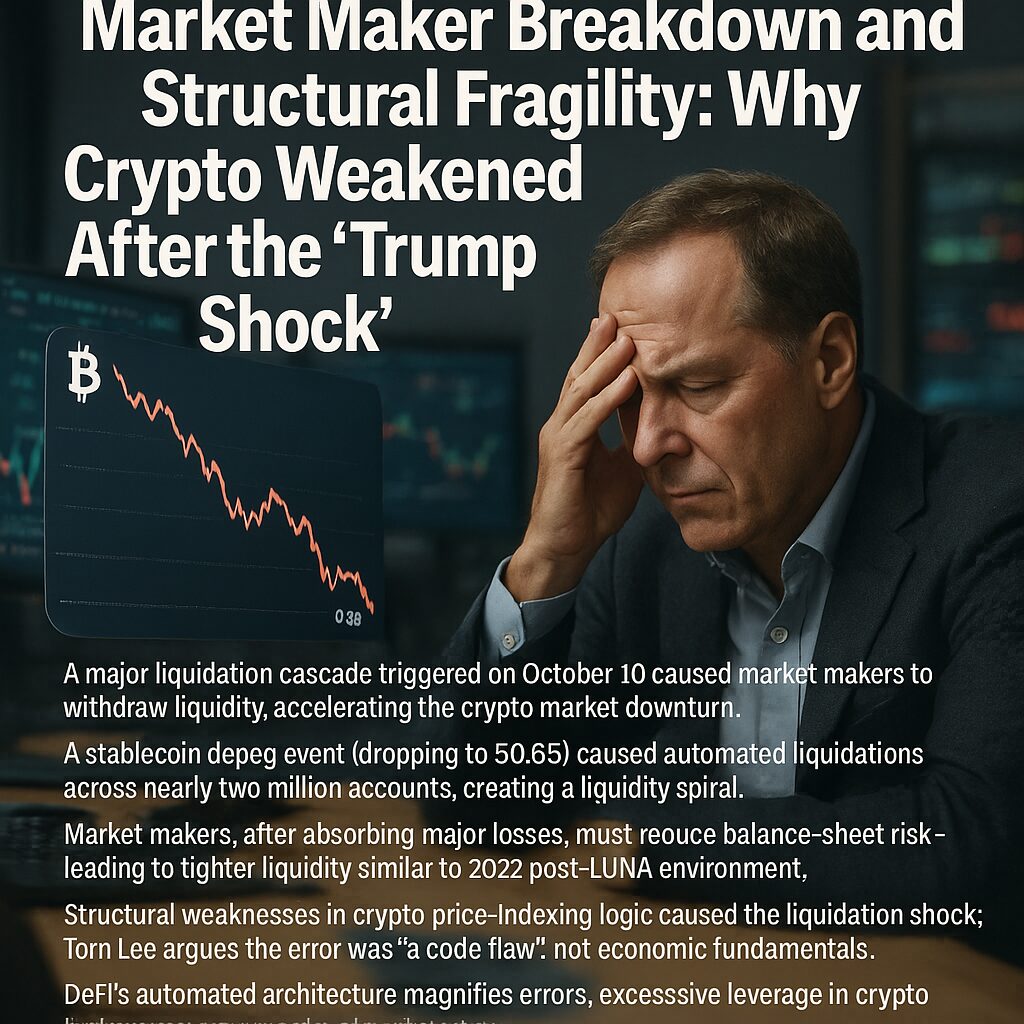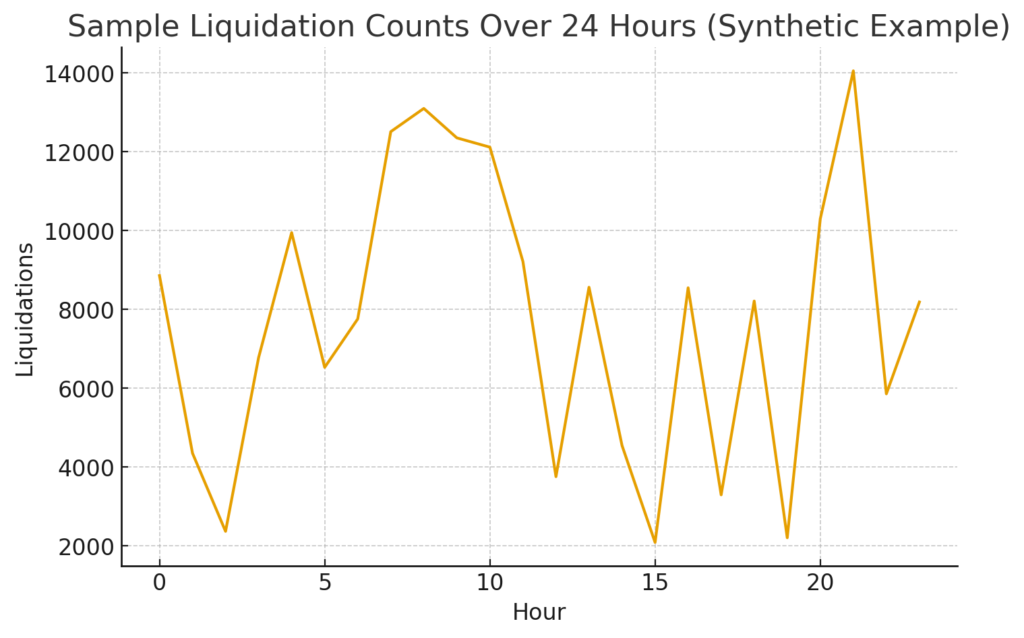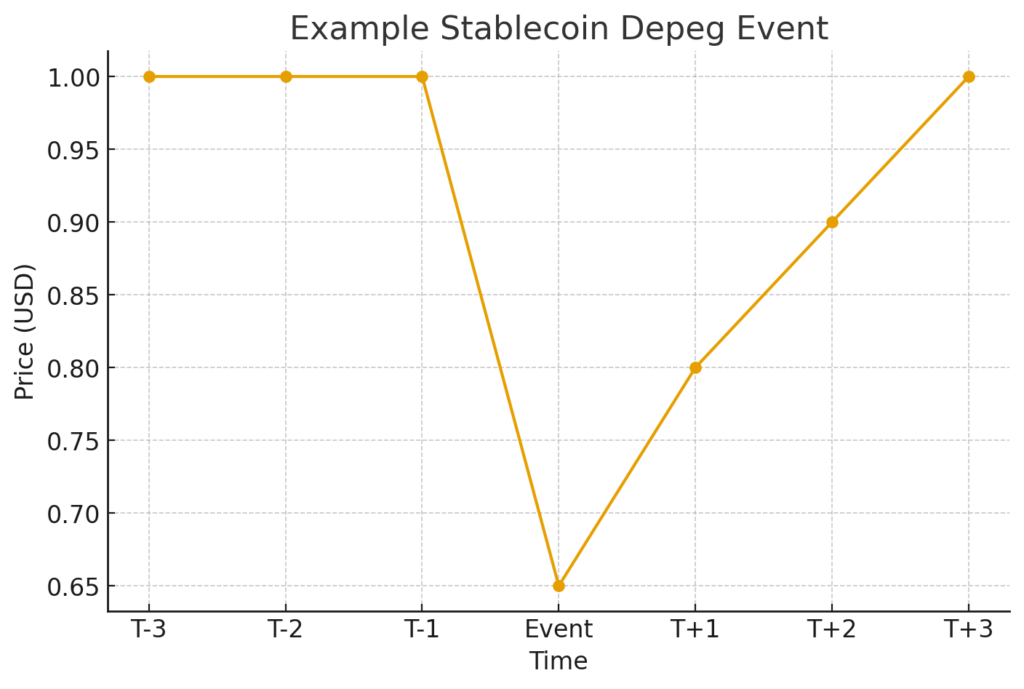
Main Points :
- A major liquidation cascade triggered on October 10 caused market makers to withdraw liquidity, accelerating the crypto market downturn.
- A stablecoin depeg event (dropping to $0.65) caused automated liquidations across nearly two million accounts, creating a liquidity spiral.
- Market makers, after absorbing major losses, must reduce balance-sheet risk—leading to tighter liquidity similar to the 2022 post-LUNA environment.
- Structural weaknesses in crypto price-indexing logic caused the liquidation shock; Tom Lee argues the error was “a code flaw,” not economic fundamentals.
- DeFi’s automated architecture magnifies errors; excessive leverage in crypto trading remains a systemic vulnerability.
- For investors seeking new crypto opportunities, this period may resemble prior accumulation phases where liquidity bottoms precede strong multi-month recoveries.
1. Introduction: Post–October 10 Weakness and Market Instability
The cryptocurrency market has been under pressure since October 10, following the sudden geopolitical shock triggered by President Donald Trump’s announcement of sharply increased tariffs on China. Although the macro headline drew immediate selling, the prolonged weakness of the market cannot be explained by sentiment alone.
Tom Lee, Chairman of Bitmine Immersion Technologies—a firm widely recognized as one of the largest Ethereum treasury operators—argues that the ongoing downturn reflects structural liquidity impairment, not mere market fear.
According to Lee, a massive liquidation wave on October 10 destabilized market makers, leading to a multi-week period of weakened liquidity reminiscent of similar events in 2022. He emphasizes that this is not a normal correction, but a delayed effect caused by a breakdown in the trading infrastructure that supports crypto pricing and liquidity.
2. Market Makers and Why Their Impairment Matters
Market makers are professional liquidity providers who place buy and sell orders on exchanges to ensure smooth trading. They are essential for narrowing spreads, minimizing volatility, and providing depth across spot and derivatives markets.
When market makers take large losses—as they did during the October 10 liquidation—they must shrink their balance sheets to manage risk:
- They reduce their trading inventory
- They widen spreads
- They provide fewer two-sided quotes
- They retreat from volatile token pairs
This systemic deleveraging leads to thin order books. Even small sell pressure can trigger outsized price drops, which in turn produce further liquidations—creating a negative feedback loop.
Lee notes that the current environment mirrors 2022, when market maker impairment took nearly eight weeks to resolve. As of mid-November 2025, we are only six weeks into the healing process.
3. The Stablecoin That Fell to $0.65—and Why It Triggered 2 Million Liquidations
Lee highlights that the liquidation event was amplified by a severe depeg on one major synthetic stablecoin. In one exchange, the coin dropped from its intended $1 peg to $0.65, instantly triggering automated liquidation systems.
These factors created a cascading failure:
- Stablecoin depegged to $0.65
- Automated liquidation bots interpreted this as collateral collapse
- Accounts using this asset as margin were liquidated
- Forced selling spilled into other exchanges
- Even profitable traders were liquidated due to cross-platform collateral links
Lee estimates that approximately 2 million accounts were liquidated during the event, a figure rarely seen in crypto history.

He suggests the root cause was not a macro event but a technical flaw. In his view:
- The liquidation engine relied on an internal price feed,
- instead of pulling weighted price indices from multiple exchanges,
- causing an erroneous valuation that triggered a market-wide chain reaction.

4. Binance’s Response: New Safety Parameters and Pricing Logic Fixes
Although Lee did not name specific exchanges, on October 10 Binance experienced abnormal price movements in various synthetic stablecoins including USDe, which briefly fell below $0.60.
Binance later acknowledged the anomaly and implemented corrective measures:
- Adjustment of price-index parameters
- Inclusion of redemption price weightings
- Introduction of rate-limiting thresholds to prevent runaway liquidation loops
They also launched an extraordinary compensation program worth approximately $430 million, citing “abnormal market behavior related to the Trump shock.”
These measures indicate that major exchanges now recognize the systemic risk caused by fragile liquidation engines and non-robust price-index logic.
5. Why This Matters: Liquidity Fragility and the Role of Code in DeFi
In traditional financial markets, pricing errors or faulty liquidation algorithms would be halted by circuit breakers. In crypto and DeFi environments, however, automated liquidations execute instantly and relentlessly.
This automation has two implications:
- Errors propagate faster than human-mediated trading
- Blame shifts from trader behavior to code robustness
As Lee explains, DeFi inherently contains the possibility of code errors. Smart-contract logic determines whether a user is liquidated—not an analyst or risk manager.
This is why DeFi liquidation engines must use:
- Cross-exchange price oracles
- Decentralized data feeds
- Weighted, time-smoothed price indices
- Fallback logic in the event of anomalies
The October 10 event demonstrates that even large, well-capitalized exchanges are vulnerable to cascading liquidations triggered by a single price anomaly.
6. Historical Parallels: From LUNA (2022) to the Present
The current environment resembles the early months of 2022:
- Liquidity dried up
- Spreads widened
- Market makers retreated
- Stablecoins experienced structural risk
- Retail leverage collapsed
In both periods, automated liquidation architecture revealed its weaknesses.
However, unlike 2022—when LUNA’s collapse reflected fundamental economic flaws—the October 10 event was, in Lee’s view, a fixable technical error, not a systemic failure in crypto itself.
This distinction matters greatly for investors looking for opportunities.
7. Investment Perspective: Opportunities for Accumulators
With liquidity impaired and sentiment low, many tokens are trading below their fair-value metrics. Historically:

- Low-liquidity environments
- Followed by market-maker recovery
- Often lead to multi-week relief rallies
Long-term investors may view this period as:
- A chance to accumulate high-conviction assets (BTC, ETH)
- A time to explore emerging sectors like RWA tokens, AI-crypto infrastructure, and L2 settlement networks
- An opportunity to reassess stablecoins and verify the robustness of their price-index mechanisms
For investors searching for new assets and practical blockchain revenue opportunities, moments of temporary liquidity breakdown often precede strong rebounds.
8. Lessons for Builders and Exchanges
This incident exposes several structural weaknesses:
1. Reliance on single-exchange price feeds is dangerous
Multiple independent oracle sources must be used.
2. Over-leveraged retail trading magnifies non-fundamental volatility
Platforms must encourage healthier leverage ratios.
3. Automatic liquidation bots require cross-check logic
Fallback price bands or multi-oracle confirmation should be mandatory.
4. Market makers should diversify collateral types

To avoid mass loss from a single asset’s mispricing.
As Lee notes, these issues are solvable.
Once repaired, the crypto market could normalize faster than in 2022.
9. Conclusion: A Recoverable Failure, Not a Structural Collapse
Tom Lee’s analysis reframes the October 10 downturn not as a macro-driven collapse, but as a liquidity fracture caused by a technical error.
The market’s weakness reflects temporary impairment in market-maker balance sheets and cascading automated liquidations—not a loss of faith in crypto fundamentals.
Stablecoin technology, liquidation bots, and price-feed architecture must evolve, but the broader crypto ecosystem remains intact.
If anything, this episode will push exchanges and DeFi developers toward safer, more robust pricing engines. For investors seeking new crypto assets, emerging yield opportunities, and practical blockchain deployments, the current environment may mark the beginning of a new accumulation phase rather than the end of one.

